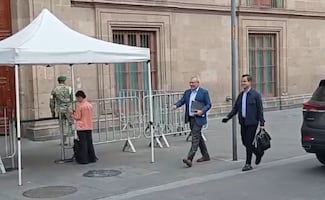Más Información

Senador del PT propone crear televisión, radio y periódico de la 4T; debemos hacer frente a medios de derecha, dice

César Duarte comparece ante jueza en penal del Altiplano; buscan vincularlo por presunto lavado de dinero

¿Qué es el Tratado de Aguas de 1944 entre México y EU por el que Trump amaga con imponer aranceles?; te explicamos

Gobernador de Michoacán se reúne con Sheinbaum en Palacio Nacional; acude también gabinete de Seguridad

Posponen en el Senado discusión y votación de reforma para crear la figura de “jueces sin rostro”; se discutirá en febrero

VIDEO Hallan a pareja sin vida en colonia Lindavista; una de las víctimas era abogado que litigó temas de despojos en Ecatepec
Donald Trump
has threatened to close the U.S. border if Mexico does not halt all illegal immigration , blaming Mexico for the flow of Central American migrants.
Amid a surge in migrant detentions at the U.S. border , Trump claimed he would close the 2,000-mile frontier or sections of it this week if Mexico did not halt the flow of people.
Casting the Mexican government led by President Andrés Manuel López Obrador as the villain in his struggle to curb illegal immigration to the United States , Trump returned to a signature theme of his 2015-2016 presidential election bid.
Mexico's Foreign Minister Marcelo Ebrard said Mexico won't act based on threats and said the country would act with dignity and responsibility in regards to migration .
Nevertheless, President López Obrador has refused to answer back to provocative comments from Trump . Instead, the Mexican leader announced he would create jobs for the Central American migrants and emphasized the need to tackle poverty and violence in the region.
Staunchly non-interventionist in international affairs , López Obrador shows little interest in diplomacy . He has often said “the best foreign policy is domestic policy .”
But as the destination of 80% of Mexico ’s exports and workplace of hundreds of thousands of Mexicans , the United States offers Trump plenty of advantage to apply pressure via the border .
Nevertheless, policy experts say Trump ’s threat is not realistic and that Mexican authorities are already stretched.
Still, Mexico has signaled it will redouble efforts to contain migration , which stems largely from three poor, violent Central American countries : Guatemala, Honduras , and El Salvador .
The Mexican government has vowed to curb migration by addressing the root causes, keeping better tabs on the people entering Mexico , and adopting a more humane approach to the phenomenon.
In exchange, López Obrador has sought to enlist Trump’s aid in tackling the problems of Central America , which critics say has been scarred by a history of messy U.S. interventions .
On Thursday, López Obrador said migration was chiefly a matter for Washington and the troubled region, reflecting the view that Mexico cannot help being sandwiched between the struggling countries and the richest nation on the planet.
But on Saturday, the U.S. State Department said it was cutting off aid to El Salvador, Guatemala, and Honduras , raising questions about Trump’s commitment to helping this region.
There has also been a soar in border arrests. U.S. Customs and Border Patrol projections are for over 90,000 apprehensions to be logged during March, according to data provided to the Mexican government . That is up more than 140% from March 2018, and a seven-fold jump from 2017.
At the same time, López Obrador is sending fewer migrants back home. From December 2018 to February 2019, the number dropped 17% from a year earlier to 19,360, data from the National Migration Institute show.
The fall partly reflects the government’s decision to issue humanitarian visas to encourage Central Americans to stay in Mexico . The visas were so popular that the government had to suspend them, officials say.
The clash illustrates López Obrador ’s miscalculation in thinking he could contain Trump’s hostility toward Mexico, said Agustín Barrios Gómez , a member of the Mexican Council on Foreign Relations.
Tension was inevitable given that Trump’s tough stance on illegal immigration is “immediately antagonistic” to López Obrador ’s core constituency: poorer Mexicans who often seek to better their lot in the United States, he argued.
Yet by agreeing to accept Central American asylum seekers while their claims are processed in the United States , López Obrador gave the impression he could be “pushed around” by Trump , said former Foreign Minister Jorge Castaneda.
To keep the border open, Mexican business leaders say they are leaning on U.S. partners to pressure Congress because a shutdown would be “very negative for both countries,” said Deputy Economy Minister Luz María de la Mora , who saw Trump’s comments as part of his election campaign.
“I think the U.S. administration and the advisers in the White House know it’s not a good idea,” she told Reuters.
But if push came to shove, Mexico would suffer most, said Castaneda .
Today, President López Obrador said Mexico will help to regulate the flow of Central American migrants passing through its territory to the United States , but that the root causes behind the phenomenon must be tackled.
Speaking after Donald Trump threatened to close the U.S. southern border if Mexico did not halt illegal immigration immediately, López Obrador said he would not have a confrontation with the United States .
“I prefer love and peace,” López Obrador told reporters at his regular morning news conference.
López Obrador
has tried to persuade Trump to address the problem by fostering economic development in Central America . But the U.S. State Department is now cutting off aid to El Salvador, Guatemala, and Honduras.
When asked if it was time to put pressure on the Central American countries to do more to tackle the problem, López Obrador said the causes of migration were “not being attended to” and that people needed to be offered more opportunities there.
“Obviously, we have to help because Central American migrants pass through our territory and we have to bring order to this migration, make sure it’s legal,” López Obrador said.
Meanwhile, U.S. Secretary of State Mike Pompeo said the United States was working with the Central American governments and Mexico to “solve this problem at the border,” and pointed to the numbers when asked why Trump had toughened his stance.
“Just look at the math,” Pompeo told reporters. “How many folks are coming across. This is a crisis . We need to fix it.”
gm
Noticias según tus intereses
[Publicidad]
[Publicidad]









